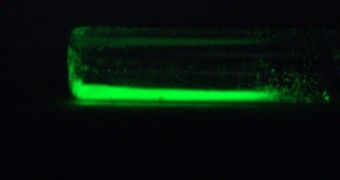Radium (Ra) is a rare element, almost pure white, extremely radioactive and found in trace amounts in uranium ores. It is luminescent, giving a faint blue color and reacts violently with water.
A group of physicists led by Argonne Compton Postdoctoral Fellow Jeffrey Guest of Argonne's Physics Division has been attempting applications involving the trapping of the rare, radioactive element for studies of time-reversal violation. This could have huge implications for physics beyond the Standard Model and for explaining why the Big Bang yielded an imbalance between matter and antimatter in the universe.
As radium is very rare, scientists were using less than a millionth of a gram of radium that they vaporized and laser-cooled to trap the atoms in a magneto-optical trap.
"This is the first time this rare element has been laser-cooled and trapped," Guest said. "It is the heaviest atom and only the second element with no stable isotopes - after francium - laser-trapped so far. It was particularly challenging to trap radium because quantities are scarce, and the atomic structure is not well studied and understood."
Radium atoms were slowed to a near-complete halt and captured using magnetic fields and laser beams tuned near the atoms' resonant frequency. Further experiments will probe the cold radium atoms using lasers as they spin in place within a large electric field. The atoms will precess, that is they will wobble about their axes like tops winding down, while they spin. The frequency of this precession may reveal a slight offset between the negative and positive charge within the atom along its spin axis, a signature of time-reversal violation.
"Because their nuclei are egg-shaped, radium nuclei should be very sensitive to the time-reversal effects we want to investigate," Guest said. "However, radium is difficult to work with. Atoms tend to drift out of the trap, and because of radium's chemistry, it would stick to the walls of the vacuum chamber."
The unexpected help came from blackbody radiation, a spectral radiance of electromagnetic radiation at all wavelengths from a black body at a specific temperature, in this case infrared radiation coming from the room-temperature walls of the apparatus.
In normal laboratory conditions, this radiation is a problem for scientists, causing heating, contributing to background noise and scrambling quantum phases, but this time researchers were surprised to find the radium atoms staying put much longer than expected because of this radiation.
"We were surprised to discover that room temperature blackbody radiation actually played a pivotal and supportive role. This mechanism may be helpful in trapping other atoms with complex structure," Guest said.

 14 DAY TRIAL //
14 DAY TRIAL //